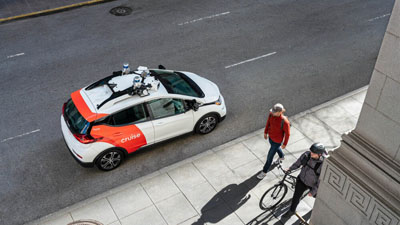J.D. Power surveyed people in cities where Cruise and Waymo have deployed self-driving taxis to gauge their feelings.
Consumers are not comfortable with the testing and deployment of robotaxis1 on their city streets, according to the inaugural J.D. Power U.S. Robotaxi Experience Study, released Oct. 19.
The study provides the first consumer feedback from robotaxi riders and those who have interacted with robotaxis as non-riders in their community in San Francisco, CA, and Phoenix, AZ. Findings show only 27% of non-riders are comfortable sharing the road with robotaxis and just 20% of all consumers nationally are comfortable with AV technology being tested on streets and highways near them.
However, robotaxi riders---who are new-tech adopters---are critical ambassadors for AV technology, as most tend to tout a positive experience. Consumer confidence in AV technology is fragile and positive first-hand experiences tend to build consumer trust. Among riders, 47% gained trust during a ride and 51% maintained their already high level of trust in the technology during a ride. It is notable only 2% of riders lost trust in robotaxi capability during a ride experience.
These positive firsthand experiences can help educate other consumers, providing balance to news coverage that often focuses solely on the negative aspects of AVs. While many non-riders express concern for their safety and lack of trust in the technology as reasons they have not yet ridden in an AV, 81% express a desire to hear about others’ experiences before they ride in one.
“Automated vehicle technology is built on the promise of alleviating distracted driving, impaired driving and collisions attributed to human error,” said Kathleen Rizk, senior director of user experience benchmarking and technology at J.D. Power. “However, the benefits result from consumer acceptance, which is why it’s imperative to ensure these first deployments are flawless---not only for the riders but also especially for those who are not early adopters, including non-riders who are experiencing AVs in their community and those learning from a distance through social media and other news outlets.”
Key Findings
Inquisitive consumers drive initial robotaxi usage: As with most new technologies, consumer interest in robotaxi usage is garnered by general curiosity (40%) and recommendations from a friend or colleague (37%). However, for the service to thrive and to establish repeat ridership, it must be viewed as more than a novelty since few riders use the service to multi-task (25%); avoid parking (22%); or don’t have the ability to drive short distances (e.g., intoxicated/under the influence of controlled substance) (18%).
Robotaxi riders’ critical needs not being met by current services: The four attributes that consumers perceive as important to consideration of using a robotaxi also have the lowest levels of satisfaction. They are cost to ride; service area coverage; accessibility for disabled passengers; and customer support during the ride. Improving performance of these key metrics is imperative for long-term adoption.
Most riders don’t think robotaxis drive better than humans: Despite the marketing hype of AVs making roads safer, nearly 60% of both riders and non-riders say they don’t think a robotaxi drives any better than a human. Those who say they think a robotaxi drives better associate it with obeying traffic laws, while those who say a robotaxi drives worse than a human mention abrupt and unnecessary stopping, as well as causing collisions/incidents.
The U.S. Robotaxi Experience Study is based on responses from 408 consumers residing in Phoenix and San Francisco where robotaxi companies (e.g., Waymo, Cruise) are testing and deploying vehicles. To qualify, respondents had to ride in a fully automated, self-driving robotaxi or see a fully automated, self-driving robotaxi. These two groups of participants are classified as riders and non-riders, respectively. The study was fielded in July.










Abby Andrews